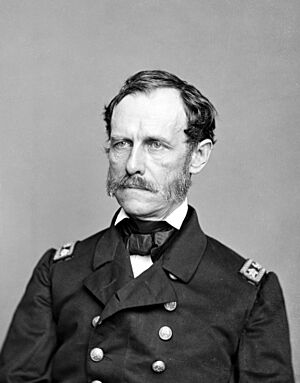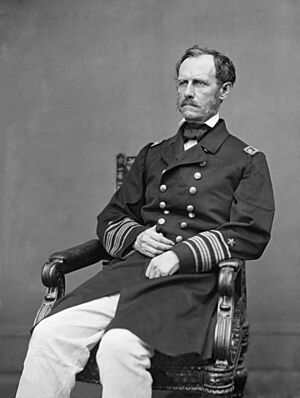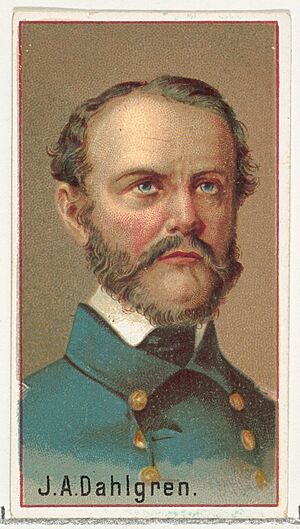John A. Dahlgren facts for kids
Quick facts for kids
John A. Dahlgren
|
|
|---|---|

Dahlgren during the American Civil War
|
|
| Birth name | John Adolphus Bernard Dahlgren |
| Nickname(s) | "Father of American naval ordnance" |
| Born | November 13, 1809 Philadelphia, Pennsylvania, U.S. |
| Died | July 12, 1870 (aged 60) Philadelphia, Pennsylvania, U.S. |
| Buried | |
| Allegiance | |
| Service/ |
|
| Years of service | 1826–1870 |
| Rank | |
| Commands held | South Atlantic Blockading Squadron South Pacific Squadron Bureau of Ordnance Washington Navy Yard |
| Battles/wars | American Civil War |
| Spouse(s) | Madeleine Vinton Dahlgren |
| Relations | John Vinton Dahlgren (son) |
John Adolphus Bernard Dahlgren (born November 13, 1809 – died July 12, 1870) was an important officer in the United States Navy. He is famous for creating the Navy's department for weapons (called the Ordnance Department). He also made big improvements in how naval guns worked.
Dahlgren invented a type of cannon called a smoothbore howitzer. This gun could be used on many different sizes of ships and on land. He then created a cast-iron cannon that loaded from the front, known as the Dahlgren gun. This new gun could shoot much farther and more accurately. It soon became the main weapon for the U.S. Navy.
During the American Civil War, Dahlgren became the commander of the Washington Navy Yard. Here, he set up the Bureau of Ordnance, which was in charge of all naval weapons. In 1863, he became a rear admiral and led the South Atlantic Blockading Squadron. He also helped General William Tecumseh Sherman take control of Savannah, Georgia.
Contents
Early Life and Education
John Dahlgren was born in Philadelphia, Pennsylvania, on November 13, 1809. His father, Bernhard Ulrik Dahlgren, was a merchant and also worked as the Swedish Consul in the city.
Dahlgren joined the United States Navy in 1826 as a midshipman, which is an officer in training. In 1834, he was promoted to work on coastal surveys. By 1847, he became an officer specializing in weapons. At the Washington Navy Yard, he started to improve how the Navy bought and supplied its weapons.
In 1847, Dahlgren was sent to the Washington Navy Yard. While there, he created the U.S. Navy's Ordnance Department. This made him an expert in naval weapons. He invented a new type of firing mechanism for guns called a percussion lock. He also wrote several important books about naval weapons. These included The System of Boat Armaments in the United States Navy and Shells and Shell Guns.
Under his leadership, the U.S. Navy built its own factory (called a foundry) to make new equipment. The first weapon they produced was the boat howitzer. This gun was designed to be used on ships and for landing parties on shore.
The Famous Dahlgren Gun
John Dahlgren's most famous invention was the Dahlgren gun. This was a cast-iron cannon that loaded from the front (muzzle-loading). Dahlgren did a lot of careful research. He used special tools to measure how pressure changed inside the cannon barrel when it fired. This helped him design a gun that used gunpowder which burned slower.
His goal was to create a gun that could fire shells far and accurately. It also needed to be able to fire solid cannonballs when needed. He wanted all the guns on a ship to be this type of gun, rather than mixing different kinds.
By 1852, the Dahlgren gun became the main weapon used by the United States Navy.
The boat howitzer was another important invention. It was needed because during the Mexican–American War, naval landing parties used army weapons that were often too heavy for their boats. Dahlgren first tried using army howitzers. Then, he designed his own system of guns.
These boat howitzers came in different sizes: small, light, heavy 12-pounders, and a larger 24-pounder. They all looked similar, with straight gun barrels. They could be aimed up or down using a screw at the back. Instead of traditional pivots, these guns were attached to their carriages by a loop under the barrel.
The Dahlgren system also included special carriages for using the guns in different ways. There was a metal carriage with one axle for use on land. For small boats, a special bed-type carriage allowed the gun to move forward, backward, and to the sides. A similar mount was used on larger ships. The boat howitzer system was used by the U.S. Navy for a long time, even into the 1890s. Some were even used for ceremonies in the 20th century.
Role in the American Civil War

In 1861, Dahlgren's boss at the Washington Navy Yard left to join the Confederate navy. President Abraham Lincoln wanted to make Commander Dahlgren the new head of the Washington Navy Yard. However, by law, only an officer with the rank of captain or higher could hold that job. Lincoln convinced Congress to pass a special law so Dahlgren could be appointed.
In July 1862, Dahlgren was promoted to captain and became the chief of the Bureau of Ordnance. In February 1863, he was promoted again to rear admiral. He then took command of the South Atlantic Blockading Squadron. In 1864, he helped General William Tecumseh Sherman secure Savannah, Georgia.
Dahlgren's oldest son, Charles Bunker Dahlgren (1839–1912), also joined the U.S. Navy at the start of the Civil War. He was an engineer and served well, becoming a captain. He commanded a group of 9-inch Dahlgren guns that helped destroy Confederate defenses at the Battle of Vicksburg. He also served under his father during the blockade of Charleston.
Another of Dahlgren's sons, Colonel Ulric Dahlgren, was killed on March 2, 1864. He died during a cavalry raid on Richmond, Virginia.
Personal Life
Dahlgren had three sons from his first marriage to Mary Bunker. His oldest son, Charles Bunker Dahlgren, was an engineer and a captain in the Union Navy. After his father passed away, Charles wrote many technical papers about military weapons, including the Dahlgren gun.
Ulric Dahlgren (1842–1864) was a soldier in the Union Army. He was killed during a mission to free Federal prisoners in Libby Prison and Belle Isle. Another son, Paul Dahlgren, also served in the army. He died in 1876 while working as a consul general in Rome.
In 1865, Dahlgren married his second wife, Madeleine Vinton Dahlgren. She was the daughter of Congressman Samuel Finley Vinton. Madeleine was also a well-known author. They had three children: John Vinton Dahlgren, Eric Bernard Dahlgren Sr., and Ulrica Dahlgren.
Later Years and Death
In 1867, Dahlgren took command of the South Pacific Squadron. When he finished that command in 1868, he returned to the Washington Navy Yard. He again served as chief of the Bureau of Ordnance until 1869. After that, he was the commandant (leader) of the yard until he died on July 12, 1870, at the age of 60.
He is buried at Laurel Hill Cemetery in Bala Cynwyd, Pennsylvania.
Legacy
Many places and things are named after John A. Dahlgren. These include the Naval station in Dahlgren, Virginia, Dahlgren Hall at the United States Naval Academy in Annapolis, Maryland, and several ships. Also, the towns of Dahlgren, Illinois, and Dahlgren Township, Minnesota are named for him.
Selected Works
- The System of Boat Armaments in the United States Navy
- Shells and Shell Guns
- Naval Percussion Locks and Primers
See also
- Dahlgren Chapel (Maryland), a chapel built by Dahlgren's widow
- Naval Surface Warfare Center Dahlgren Division
- USS Dahlgren, a ship named after him





